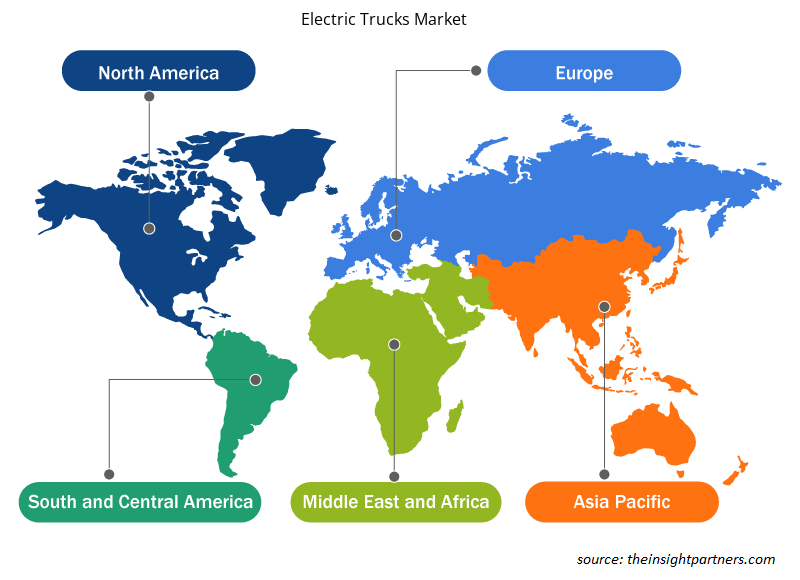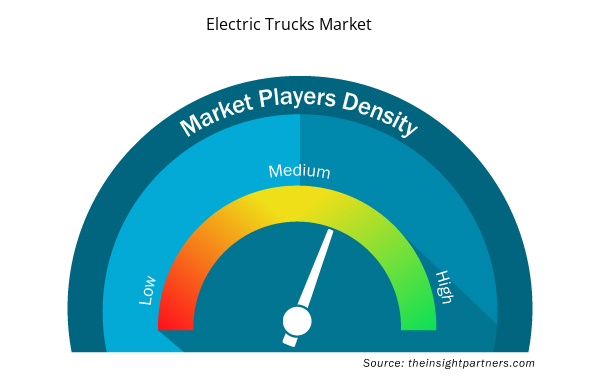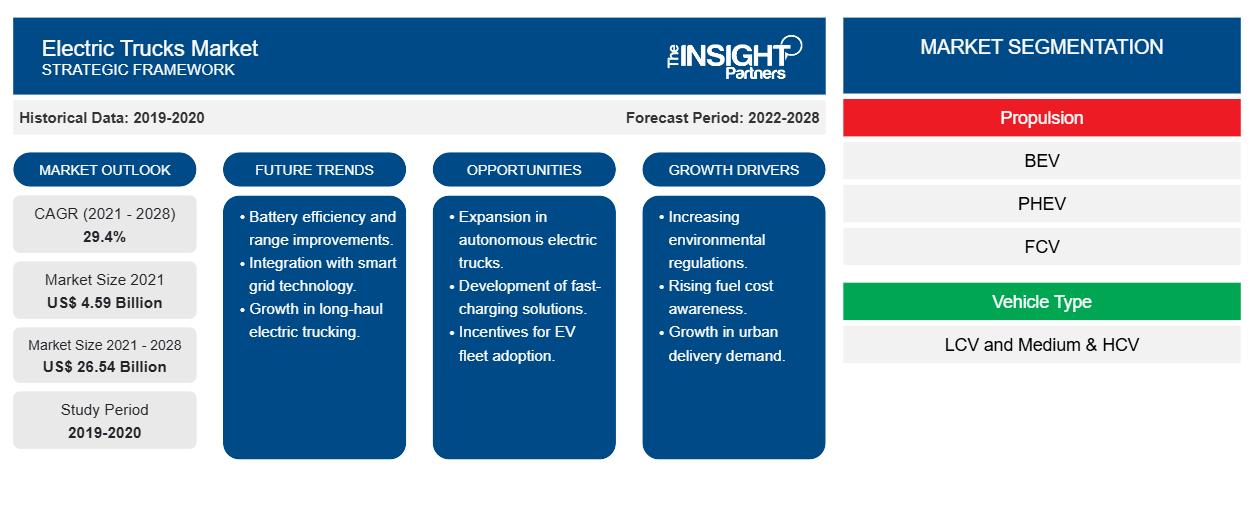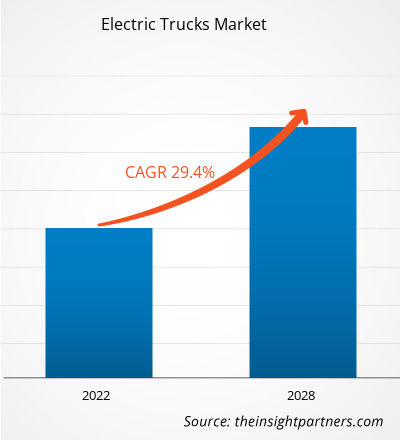電気トラック市場は、2021年の45億9,255万米ドルから2028年には265億4,290万米ドルに成長すると予想されており、2022年から2028年にかけて29.4%のCAGRで成長すると予測されています。
世界の自動車業界は、代替ソリューションやエネルギー消費量の少ないソリューションへの段階的な移行により、パラダイムシフトを遂げています。石油価格の高騰、汚染レベルの上昇、そして地球規模の気候変動に取り組むという国際的な誓約により、e-モビリティへの移行が加速しています。
電気トラック市場における最近の主な動向:
- 2021年8月、ボルボ・トラックは、江鈴汽車有限公司の子会社である江鈴重機重型車両有限公司の中国における大型トラック製造施設を買収しました。この買収には、中国山西省太原の生産施設も含まれます。目標は、2022年末までに太原で中国の顧客向けに新型大型トラック、ボルボFH、ボルボFM、ボルボFMXの製造を開始することです。
- 2021年9月、BYDはカリフォルニアのACT Expoで革新的なバッテリー電気大型トラック2台を発表しました。このトラックには先進運転支援システム(ADAS)が標準装備されており、運転がより簡単かつ安全になります。
推進力に基づいて、電気トラック市場はBEV、PHEV、FCEVに分類されます。2021年には、BEVセグメントが最大のシェアで市場をリードしました。車両に基づいて、電気トラック市場はLCV、中型およびHCVに分類されます。2021年には、LCVセグメントがより大きなシェアで市場をリードしました。航続距離に基づいて、電気トラック市場は200マイル未満と200マイル以上に分かれています。2021年には、200マイル以上のセグメントが市場で大きなシェアを占めました。自動化のレベルに基づいて、電気トラック市場は半自律型と完全自律型に分かれています。2021年には、半自律型セグメントが大きなシェアで市場をリードしました。地域別に見ると、電気トラック市場は主に北米、ヨーロッパ、アジア太平洋(APAC)、中東およびアフリカ(MEA)、南米(SAM)に分かれています。 2021年、ヨーロッパは市場の大きなシェアを占めた
要件に合わせてレポートをカスタマイズする
このレポートの一部、国レベルの分析、Excelデータパックなど、あらゆるレポートを無料でカスタマイズできます。また、スタートアップや大学向けのお得なオファーや割引もご利用いただけます。
- このレポートの主要な市場動向を入手してください。この無料サンプルには、市場動向から見積もりや予測に至るまでのデータ分析が含まれます。
COVID-19パンデミックが電気トラック市場に与える影響
2020年、COVID-19パンデミックは自動車生産の減少により電気トラック市場の成長を妨げました。COVID-19はさまざまな地域のEV市場にさまざまな程度の影響を与えました。多くのEV OEMは、社会的距離を置く傾向と購入時に混雑を避けたくない消費者に対応して、オンラインビジネスモデルと非接触型販売チャネルの構築を試みています。それにもかかわらず、COVID後の需要の急増により、2020年を通じて新しいEV工場の建設計画が設定されました。しかし、2020年の最初の3四半期では、COVID-19のため、新設されたEV工場のいずれも稼働しませんでした。
市場洞察 – 電気トラック市場
持続可能なモビリティの採用が増加
持続可能なモビリティの採用の増加により、要求が厳しく重量のある長距離輸送業務向けに、電気トラック(長距離バッテリー電気トラックや燃料電池電気トラックなど)やその他の電気車両の導入が促進されています。水素燃料電池を燃料とする電気トラックは、2022~2028年に利用可能になると予想されています。気候が輸送に与える影響を軽減するには、化石燃料から電気などの代替燃料への迅速な移行が必要です。その結果、ほとんどの輸送事業者は段階的に電気車両に移行する可能性があります。移行期間中、多くの事業者は異なる燃料を燃料とするトラックの混合車両を保有することになります。
電気自動車は、より効率的でクリーンな輸送を通じてエネルギーを節約し、国連が定めた持続可能な開発目標 (SDGs) を政府が達成することを可能にします。電気トラックは、他の電気自動車と同様に、排気ガスによる汚染の削減、化石燃料への依存の軽減、地域社会の健康の促進、エネルギー安全保障の提供、雇用とスキルアップの機会の改善に役立ちます。電気自動車の目標と再生可能エネルギーの目標を組み合わせることで、輸送業界の脱炭素化がさらに促進されます。欧州および発展途上地域の企業や政府機関は、EV 充電インフラを提供し、フリート車両を電気トラックに移行することで、世界の温室効果ガス排出量を削減し、電気トラックの採用を促進する上で大きな役割を果たす可能性があります。
推進力に基づく洞察
推進力に基づいて、電気トラック市場はBEV、FCV、PHEVに分類されます。BEVセグメントは2021年に最大の市場シェアを占めました。バッテリー駆動の電気トラックは、市場の成長に大きく貢献すると予想されています。ボルボやナビスターなどのメーカーは、自社の技術力を活用し、BEVの開発サイクルを短縮し、市場投入までの時間を短縮することに重点を置いています。バッテリー寿命とエネルギー密度の向上、およびバッテリー価格の低下により、BEVセグメントの電気トラック市場が拡大する可能性があります。
車両ベースの洞察
車両タイプに基づいて、電気トラック市場はLCVと中型およびHCVに分かれています。 LCVセグメントは2021年に大きな市場シェアで市場をリードしました。自動車メーカーと関連するパワートレイン部品サプライヤーは、電動でクリーンかつ持続可能な未来を受け入れています。初期段階から新しいパラダイムを作成することにより、いくつかのOEMはLCVプラットフォームを確立する従来の方法を変えています。多くの主要なOEMは、特定のeLCVプラットフォームを開発しています。一方、フリートマネージャーによる高度なカスタマイズの需要の高まりと、新しいサービスベースのモデルの導入は、LCV業界に利益をもたらしています。
範囲ベースの洞察
電気トラック市場は、航続距離に基づいて、200マイル未満と200マイル以上に分類されます。200マイル以上のセグメントは、2021年に大きなシェアで市場をリードしました。エンドユーザーの間で大きな好みがあるため、航続距離の長い商用車が世界市場を支配しています。
自動化に基づく洞察
自動化のレベルに基づいて、電気トラック市場は半自律型と完全自律型に分類されます。半自律型の電気トラックは市場で大きなシェアを占めています。しかし、あらゆる業界で自動化の採用が増え、自動運転トラックの完全な機能を可能にする技術が進化しているため、今後数年間は完全自律型のトラックが市場を支配すると予想されています。
電気トラック市場の地域別洞察
予測期間を通じて電気トラック市場に影響を与える地域的な傾向と要因は、Insight Partners のアナリストによって徹底的に説明されています。このセクションでは、北米、ヨーロッパ、アジア太平洋、中東、アフリカ、南米、中米にわたる電気トラック市場のセグメントと地理についても説明します。

- 電気トラック市場の地域別データを入手
電気トラック市場レポートの範囲
| レポート属性 | 詳細 |
|---|---|
| 2021年の市場規模 | 45億9000万米ドル |
| 2028年までの市場規模 | 265.4億米ドル |
| 世界のCAGR(2021年~2028年) | 29.4% |
| 履歴データ | 2019-2020 |
| 予測期間 | 2022-2028 |
| 対象セグメント | 推進力によって
|
| 対象地域と国 | 北米
|
| 市場リーダーと主要企業プロフィール |
|
市場プレーヤーの密度:ビジネスダイナミクスへの影響を理解する
電気トラック市場は、消費者の嗜好の変化、技術の進歩、製品の利点に対する認識の高まりなどの要因により、エンドユーザーの需要が高まり、急速に成長しています。需要が高まるにつれて、企業は提供を拡大し、消費者のニーズを満たすために革新し、新たなトレンドを活用し、市場の成長をさらに促進しています。
市場プレーヤー密度とは、特定の市場または業界内で活動している企業または会社の分布を指します。これは、特定の市場スペースに、その規模または総市場価値と比較して、どれだけの競合相手 (市場プレーヤー) が存在するかを示します。
電気トラック市場で事業を展開している主要企業は次のとおりです。
- ABボルボ
- BYD株式会社
- ダイムラーAG
- 一汽グループ株式会社
- ナビスター株式会社
免責事項:上記の企業は、特定の順序でランク付けされていません。

- 電気トラック市場のトップキープレーヤーの概要を入手
電気トラック市場レポートによると、市場で活動している企業は主に新製品の発売に重点を置いています。
- 2021 年初頭、ボルボ・トラックは新型ボルボ FM 電気トラック モデルを発表しました。新しい自動化機能を備えたこのモデルは、ドライバーの視認性が向上し、統合型電子制御ブレーキ システムを備えています。
- 2021 年 8 月、ナビスターは新しい完全電動国際 eMV シリーズ トラックの発売を発表しました。eMV トラックは、中型トラックの経験とゼロ排出を組み合わせ、完全に統合された電動パワートレイン ソリューションを提供するように設計されています。
- 過去2年間の分析、基準年、CAGRによる予測(7年間)
- PEST分析とSWOT分析
- 市場規模価値/数量 - 世界、地域、国
- 業界と競争環境
- Excel データセット



Report Coverage
Revenue forecast, Company Analysis, Industry landscape, Growth factors, and Trends

Segment Covered
This text is related
to segments covered.

Regional Scope
North America, Europe, Asia Pacific, Middle East & Africa, South & Central America

Country Scope
This text is related
to country scope.
よくある質問
The incremental growth of the electric trucks market during the forecast period is US$ 21950.36 million.
Europe is the fastest growing region in the global electric trucks market.
The major five companies in the electric trucks market include Tesla, Volvo, Daimler, BYD and Navister.
Based on type, the electric trucks market is bifurcated into BEV, PHEV, and FCV. In 2021, the BEV segment led the electric trucks market, accounting for the largest share in the market.
Smart charging and connected infrastructure is presenting significant potential for the future growth of the electric trucks market players.
Government initiatives and stringent emission rules to boost the electric trucks growth and surge in global production and sales of EVs are driving the growth of the electric trucks market.
Trends and growth analysis reports related to Automotive and Transportation : READ MORE..
The List of Companies - Electric Trucks Market
- AB Volvo
- BYD Company Ltd
- Daimler AG
- FAW Group Co.,Ltd.
- Navistar, Inc.
- PACCAR Inc.
- Proterra Inc.
- Rivian
- Scania
- Tesla, Inc.
The Insight Partners performs research in 4 major stages: Data Collection & Secondary Research, Primary Research, Data Analysis and Data Triangulation & Final Review.
- Data Collection and Secondary Research:
As a market research and consulting firm operating from a decade, we have published and advised several client across the globe. First step for any study will start with an assessment of currently available data and insights from existing reports. Further, historical and current market information is collected from Investor Presentations, Annual Reports, SEC Filings, etc., and other information related to company’s performance and market positioning are gathered from Paid Databases (Factiva, Hoovers, and Reuters) and various other publications available in public domain.
Several associations trade associates, technical forums, institutes, societies and organization are accessed to gain technical as well as market related insights through their publications such as research papers, blogs and press releases related to the studies are referred to get cues about the market. Further, white papers, journals, magazines, and other news articles published in last 3 years are scrutinized and analyzed to understand the current market trends.
- Primary Research:
The primarily interview analysis comprise of data obtained from industry participants interview and answers to survey questions gathered by in-house primary team.
For primary research, interviews are conducted with industry experts/CEOs/Marketing Managers/VPs/Subject Matter Experts from both demand and supply side to get a 360-degree view of the market. The primary team conducts several interviews based on the complexity of the markets to understand the various market trends and dynamics which makes research more credible and precise.
A typical research interview fulfils the following functions:
- Provides first-hand information on the market size, market trends, growth trends, competitive landscape, and outlook
- Validates and strengthens in-house secondary research findings
- Develops the analysis team’s expertise and market understanding
Primary research involves email interactions and telephone interviews for each market, category, segment, and sub-segment across geographies. The participants who typically take part in such a process include, but are not limited to:
- Industry participants: VPs, business development managers, market intelligence managers and national sales managers
- Outside experts: Valuation experts, research analysts and key opinion leaders specializing in the electronics and semiconductor industry.
Below is the breakup of our primary respondents by company, designation, and region:

Once we receive the confirmation from primary research sources or primary respondents, we finalize the base year market estimation and forecast the data as per the macroeconomic and microeconomic factors assessed during data collection.
- Data Analysis:
Once data is validated through both secondary as well as primary respondents, we finalize the market estimations by hypothesis formulation and factor analysis at regional and country level.
- Macro-Economic Factor Analysis:
We analyse macroeconomic indicators such the gross domestic product (GDP), increase in the demand for goods and services across industries, technological advancement, regional economic growth, governmental policies, the influence of COVID-19, PEST analysis, and other aspects. This analysis aids in setting benchmarks for various nations/regions and approximating market splits. Additionally, the general trend of the aforementioned components aid in determining the market's development possibilities.
- Country Level Data:
Various factors that are especially aligned to the country are taken into account to determine the market size for a certain area and country, including the presence of vendors, such as headquarters and offices, the country's GDP, demand patterns, and industry growth. To comprehend the market dynamics for the nation, a number of growth variables, inhibitors, application areas, and current market trends are researched. The aforementioned elements aid in determining the country's overall market's growth potential.
- Company Profile:
The “Table of Contents” is formulated by listing and analyzing more than 25 - 30 companies operating in the market ecosystem across geographies. However, we profile only 10 companies as a standard practice in our syndicate reports. These 10 companies comprise leading, emerging, and regional players. Nonetheless, our analysis is not restricted to the 10 listed companies, we also analyze other companies present in the market to develop a holistic view and understand the prevailing trends. The “Company Profiles” section in the report covers key facts, business description, products & services, financial information, SWOT analysis, and key developments. The financial information presented is extracted from the annual reports and official documents of the publicly listed companies. Upon collecting the information for the sections of respective companies, we verify them via various primary sources and then compile the data in respective company profiles. The company level information helps us in deriving the base number as well as in forecasting the market size.
- Developing Base Number:
Aggregation of sales statistics (2020-2022) and macro-economic factor, and other secondary and primary research insights are utilized to arrive at base number and related market shares for 2022. The data gaps are identified in this step and relevant market data is analyzed, collected from paid primary interviews or databases. On finalizing the base year market size, forecasts are developed on the basis of macro-economic, industry and market growth factors and company level analysis.
- Data Triangulation and Final Review:
The market findings and base year market size calculations are validated from supply as well as demand side. Demand side validations are based on macro-economic factor analysis and benchmarks for respective regions and countries. In case of supply side validations, revenues of major companies are estimated (in case not available) based on industry benchmark, approximate number of employees, product portfolio, and primary interviews revenues are gathered. Further revenue from target product/service segment is assessed to avoid overshooting of market statistics. In case of heavy deviations between supply and demand side values, all thes steps are repeated to achieve synchronization.
We follow an iterative model, wherein we share our research findings with Subject Matter Experts (SME’s) and Key Opinion Leaders (KOLs) until consensus view of the market is not formulated – this model negates any drastic deviation in the opinions of experts. Only validated and universally acceptable research findings are quoted in our reports.
We have important check points that we use to validate our research findings – which we call – data triangulation, where we validate the information, we generate from secondary sources with primary interviews and then we re-validate with our internal data bases and Subject matter experts. This comprehensive model enables us to deliver high quality, reliable data in shortest possible time.


 このレポートの無料サンプルを入手する
このレポートの無料サンプルを入手する